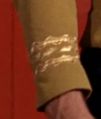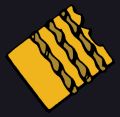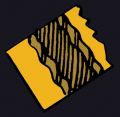Difference between revisions of "Terran Starfleet Ranks"
(Created page with "==Enlisted== ===Recruit=== ===Specialists=== ====Specialist 2nd Class==== ====Specialist 1st Class==== ====Chief Specialist==== ===Noncommissioned Officers=== ====Petty Office...") |
m |
||
| Line 51: | Line 51: | ||
File:starfleet_ranks_o6-tos06.jpg|200px|thumb|left|Captain (2265) ([[Star Trek|TOS]] [[The Naked Time (Episode)|06]]) | File:starfleet_ranks_o6-tos06.jpg|200px|thumb|left|Captain (2265) ([[Star Trek|TOS]] [[The Naked Time (Episode)|06]]) | ||
</gallery> | </gallery> | ||
| − | |||
| − | |||
| − | |||
| − | |||
| − | |||
| − | |||
| − | |||
===Flag Officers=== | ===Flag Officers=== | ||
====Commodore==== | ====Commodore==== | ||
| Line 64: | Line 57: | ||
File:starfleet_ranks_o7-fasa2001a.jpg|200px|thumb|left|Commodore (c.2260) ([[Star Trek: The Role Playing Game (FASA-2001)|FASA2001A]]) | File:starfleet_ranks_o7-fasa2001a.jpg|200px|thumb|left|Commodore (c.2260) ([[Star Trek: The Role Playing Game (FASA-2001)|FASA2001A]]) | ||
</gallery> | </gallery> | ||
| − | |||
| − | |||
| − | |||
| − | |||
| − | |||
| − | |||
| − | |||
| − | |||
| − | |||
| − | |||
| − | |||
| − | |||
| − | |||
| − | |||
| − | |||
| − | |||
| − | |||
| − | |||
====Admiral==== | ====Admiral==== | ||
The rank of Admiral was the highest in [[Starfleet]]. Admirals were responsible for the deployment of Starfleet vessels in active operations, particularly fleet operations along the border zones between the [[United Federation of Planets|Federation]] and foreign governments. Admirals were also responsible for exploration and training craft, as well as Federation colonization efforts. Staff positions encompassed a variety of roles, ranging from diplomatic and scientific to traditional planning and organizational tasks within Starfleet. Separate Admiralty Commands included directorship of Starfleet training operations, diplomatic liaisons with Federation member worlds, and negotiations with newly-discovered worlds. They also included a host of military positions: contingency strategy, weapons research and development, and scientific systems deployment aboard Starfleet vessels.<ref name="FASA2012"/> | The rank of Admiral was the highest in [[Starfleet]]. Admirals were responsible for the deployment of Starfleet vessels in active operations, particularly fleet operations along the border zones between the [[United Federation of Planets|Federation]] and foreign governments. Admirals were also responsible for exploration and training craft, as well as Federation colonization efforts. Staff positions encompassed a variety of roles, ranging from diplomatic and scientific to traditional planning and organizational tasks within Starfleet. Separate Admiralty Commands included directorship of Starfleet training operations, diplomatic liaisons with Federation member worlds, and negotiations with newly-discovered worlds. They also included a host of military positions: contingency strategy, weapons research and development, and scientific systems deployment aboard Starfleet vessels.<ref name="FASA2012"/> | ||
| Line 87: | Line 62: | ||
File:starfleet_ranks_o8-fasa2001a.jpg|200px|thumb|left|Admiral (c.2260) ([[Star Trek: The Role Playing Game (FASA-2001)|FASA2001A]]) | File:starfleet_ranks_o8-fasa2001a.jpg|200px|thumb|left|Admiral (c.2260) ([[Star Trek: The Role Playing Game (FASA-2001)|FASA2001A]]) | ||
</gallery> | </gallery> | ||
| − | + | {{References}} | |
| − | |||
<references> | <references> | ||
<ref name="TOS39">{{RefTOS39}}</ref> | <ref name="TOS39">{{RefTOS39}}</ref> | ||
| Line 99: | Line 73: | ||
[[Category:Film]] | [[Category:Film]] | ||
[[Category:TOS]] | [[Category:TOS]] | ||
| + | [[Category:DSC]] | ||
[[Category:Comics]] | [[Category:Comics]] | ||
[[Category:Games]] | [[Category:Games]] | ||
| Line 104: | Line 79: | ||
[[Category:FASA]] | [[Category:FASA]] | ||
[[Category:Decipher]] | [[Category:Decipher]] | ||
| − | |||
[[Category:Mirror Universe]] | [[Category:Mirror Universe]] | ||
Revision as of 23:53, 5 April 2020
Enlisted
Recruit
Specialists
Specialist 2nd Class
Specialist 1st Class
Chief Specialist
Noncommissioned Officers
Petty Officer
Chief Petty Officer
Senior Chief Petty Officer
Master Chief Petty Officer
Warrant Officers
Cadets
Cadet
Midshipman
Commissioned Officers
In the mid-23rd century, stripes were 2cm wide, gold, and located 6cm from the cuff.[1]
Junior Officers
Ensign
Ensigns served as junior officers in a variety of duty stations both aboard ship and at starbases and ground installations.[2]
Lieutenant, junior grade
Junior grade Lieutenants aboard ship were responsible for the direct operation of non-bridge duty stations under the supervision of senior personnel. Bridge operations involving navigation and helm control were also assigned to junior grade Lieutenants under the supervision of senior officers. At ground installations, junior grade Lieutenants typically acted as station-keepers under the direction of a senior Lieutenant.[2]
Lieutenant
Lieutenants served on Bridge command crews and as specialists aboard ships. In the absence of senior officers, Lieutenants also commanded special away teams off ship. Away from the Bridge, Lieutenants served as department heads. At starbases and ground installations, Lieutenants were in charge of specific duty stations, generally supervising from three to twelve junior officers and enlisted personnel.[2]
Line Officers
Lieutenant Commander
Officers of Lieutenant Commander rank functioned as assistant department heads or specialists. Senior Bridge officers in charge of specific watch commands were usually Lieutenant Commanders. In vessels of Class V or below, a Lieutenant Commander was frequently assigned as first officer to a ship's captain of Commander rank. Staff officers of Lieutenant Commander rank served as aides to senior officers and could, on occasion, represent their superiors on special assignments away from normal duty stations.[2]
Commander
Commanders generally headed up a department aboard ship. A senior flag Commander could have a specialized position, such as first officer or science officer. Commanders also served as ship's captain on vessels below Class V, receiving the technical distinction of Brevet Captain, which bestowed a captain's authority only aboard ship. Staff officers holding Commander rank typically served as aides to senior officers or as special duty personnel for inspection of civilian installations, liaison with native life forms, or provided administrative support.[2]
Captain
Captains commanded Starfleet vessels above Class V. Captains also directed the day-to-day operational deployment and tactical command of support craft, often without the direct influence of senior commanders. Officers with technical skills in areas such as engineering, science, medicine, or security could also receive Captain's rank and usually served aboard larger vessels. Staff officers of Captain rank typically served in deputy positions on starbases or similar ground assignments, as aides to flag officers or technical advisors to senior Federation personnel.[2]
Flag Officers
Commodore
Flag officers had generally served in a variety of vital areas, including Exploration, Military Operations, and Fleet Command. Flag officers of Commodore rank commanded Tactical Operations Groups of three to six vessels. A Commodore could also serve as a starbase commander or fleet inspector, reporting to a Rear Admiral.[2]
Commodore (c.2260) (FASA2001A)
Admiral
The rank of Admiral was the highest in Starfleet. Admirals were responsible for the deployment of Starfleet vessels in active operations, particularly fleet operations along the border zones between the Federation and foreign governments. Admirals were also responsible for exploration and training craft, as well as Federation colonization efforts. Staff positions encompassed a variety of roles, ranging from diplomatic and scientific to traditional planning and organizational tasks within Starfleet. Separate Admiralty Commands included directorship of Starfleet training operations, diplomatic liaisons with Federation member worlds, and negotiations with newly-discovered worlds. They also included a host of military positions: contingency strategy, weapons research and development, and scientific systems deployment aboard Starfleet vessels.[2]
Admiral (c.2260) (FASA2001A)
Notes and References
- ↑ Roddenberry, Gene (Executive Producer). "Mirror, Mirror." Star Trek, Season 2, Episode 10. Directed by Marc Daniels. Written by Jerome Bixby. Desilu Productions, 6 October 1967.
- ↑ 2.0 2.1 2.2 2.3 2.4 2.5 2.6 2.7 Stuart, Rick. "Star Trek: The Next Generation Officer's Manual." Star Trek: The Role Playing Game, Supplement 2012. Cover Design by Jim Nelson. Illustrations by Rob Caswell, David R. Dietrick, A.C. Farley, Dana Knutson, Jim Nelson, Jeff Laubenstein, and Todd F. Marsh. Deck Plans by Steve Venters. Cutaway Illustrations by David R. Deitrick. Ship Illustrations by Dana Knutson. FASA Corporation. 1988.





